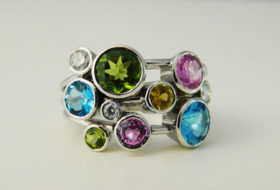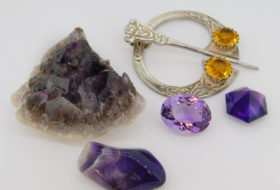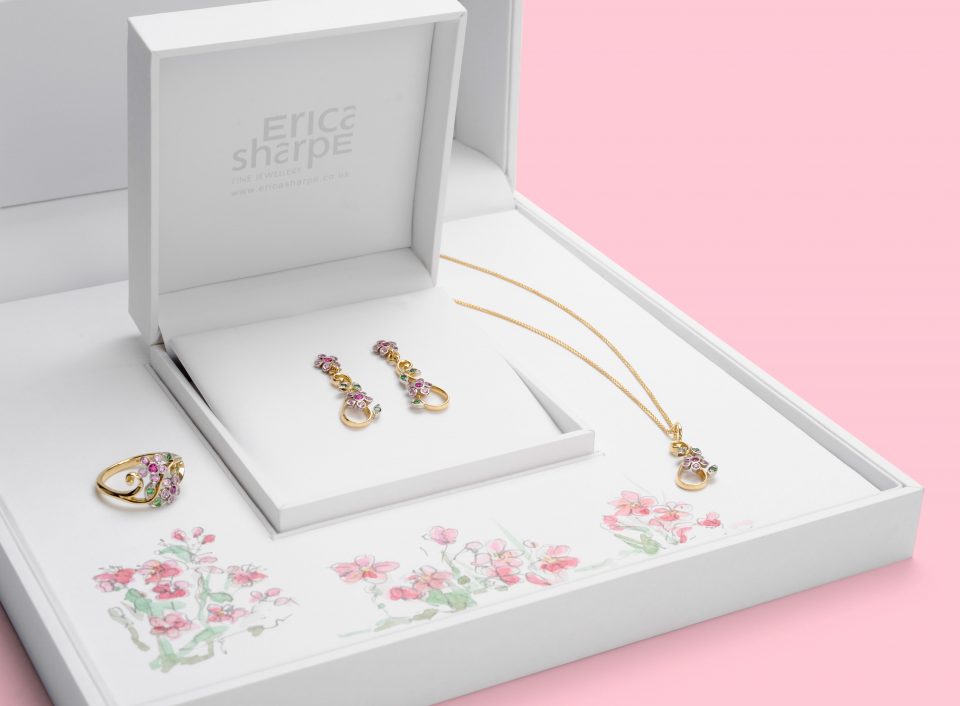What is a Crystal?
 The word ‘crystal’ derives from the Ancient Greek word krustallos, meaning both “ice” and “rock crystal“. Rock crystal is a clear, pure version of quartz and commonly used in jewellery as a gem. Quartz is the most common crystal on earth and appears in many forms. As well as rock crystal we also see citrine (yellow), rose quartz (pink) and Amethyst, the birthstone for February, which is a purple version. Quartz can form in massed tiny crystals which make up gemstones that look more like rocks, such as chalcedony (blue), adventurine (green), tiger’s eye (stripey brown with a beautiful shimmer) and more.
The word ‘crystal’ derives from the Ancient Greek word krustallos, meaning both “ice” and “rock crystal“. Rock crystal is a clear, pure version of quartz and commonly used in jewellery as a gem. Quartz is the most common crystal on earth and appears in many forms. As well as rock crystal we also see citrine (yellow), rose quartz (pink) and Amethyst, the birthstone for February, which is a purple version. Quartz can form in massed tiny crystals which make up gemstones that look more like rocks, such as chalcedony (blue), adventurine (green), tiger’s eye (stripey brown with a beautiful shimmer) and more.
The word ‘crystal’ covers a lot of meanings, not just gems. It is used to describe high quality transparent glass items like a lead crystal glass or a crystal chandelier (glass is not a crystal at all) , anything exceptionally clear (the ‘crystal’ waters of a lake), facetted and light-catching objects. It encompasses the miriad of rocks, gems, minerals, fossils and organic materials (amber, for example) that are believed to have spiritual significance and powers to help us. In the UK, a Crystal shop will sell all of the above collectables, talismans and more. In the gemstone and jewellery world, ‘crystal’ describes clear quartz (rock crystal) and the scientific meaning of the word, which is precise and specific.
In scientific terms, a crystal is ‘a solid substance having a natural 3 dimensional, geometrically regular form with symmetrically arranged plane faces’. The reason that crystals have symmetry is because their shape is determined by the way the minute atoms that they are made of are arranged, ’knitted’ or bonded together in a very ordered and regular structure. These bonds are specific to the types of atoms, so produce different symmetry for different crystalline materials.

The properties of crystal structures
The crystal structure can affect the deposition of colour within a gemstone, leaving distinct ‘bands’ or lines that are almost like the growth rings we see in a tree trunk. These bands or stripes will follow the crystal structure and line up with the atomic lattice. This can give a good indication to identity, especial if it’s a gemstone that’s been facetted and polished, thereby removing its external shape and the distinctive features of the original natural crystal. Sapphires will often display lovely colour bands, which intersect at the angles and symmetry of the natural sapphire crystal.
The properties of a crystal affect the way it interacts with light. Some crystals will ‘bend’ light-rays to such an extent, you can see an image when looking at something through them . These properties also make a difference to the way a gem stone is facetted by the gem-cutter. To produce the most sparkle and life, they have to be cut to the symmetry that suits their crystal structure.
This was written and published as part of the ‘Hidden Gems’ series of articles by Erica Sharpe for the Western Daily Press.










